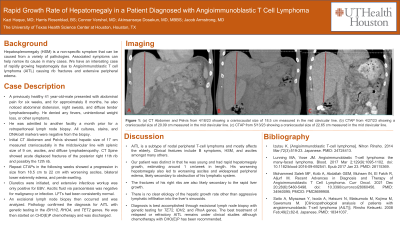Monday Poster Session
Category: Liver
P2595 - Rapid Growth Rate of Hepatomegaly in a Patient Diagnosed with Angioimmunoblastic T Cell Lymphoma
Monday, October 23, 2023
10:30 AM - 4:15 PM PT
Location: Exhibit Hall

Has Audio

Kazi Haque, MD
UTH Health Science Center at Houston
Houston, TX
Presenting Author(s)
Kazi Haque, MD1, Harris Rosenblad, BS1, Kevin Yu, MD2, Connor Vershel, MD1, Akinsan Dosekun, MBBS1, Jacob Armstrong, MD1
1UTH Health Science Center at Houston, Houston, TX; 2UT Health Science Center, Houston, TX
Introduction: Hepatosplenomegaly (HSM) is a non-specific symptom that can be caused from a variety of pathologies. Associated symptoms can help narrow its cause in many cases. We have an interesting case of rapidly growing hepatomegaly due to Angioimmunoblastic T cell lymphoma (AITL) causing rib fractures and extensive peripheral edema.
Case Description/Methods: A previously healthy 41 year-old-male presented with abdominal pain for six weeks, and for approximately 8 months, he also noticed abdominal distension, night sweats, and diffuse tender lymphadenopathy. He denied any fevers, unintentional weight loss, or other symptoms. He was admitted to another facility a month prior for a retroperitoneal lymph node biopsy. All cultures, stains, and DNA/cell markers were negative from the biopsy. Initial CT Abdomen and Pelvis showed hepatic size of 17 cm measured craniocaudally in the midclavicular line with splenic size of 9 cm, ascites, and diffuse lymphadenopathy. CT Spine showed acute displaced fractures of the posterior right 11th rib and possibly the 12th rib. Multiple repeat CTAPs in the following weeks showed a progression in size from 18.5 cm to 22 cm with worsening ascites, bilateral lower extremity edema, and penile swelling. Diuretics were initiated, and extensive infectious workup was only positive for EBV. Ascitic fluid via paracentesis was negative for malignancy or infection. LFTs had been consistently normal. An excisional lymph node biopsy then occurred and was analyzed. Pathology confirmed the diagnosis for AITL with genetic testing in the IDH1/2, RHOA, and TET2 genes. He was then started on CHO(E)P chemotherapy and was discharged.
Discussion: AITL is a subtype of nodal peripheral T-cell lymphoma and mostly affects the elderly. Clinical features include B symptoms, HSM, and ascites amongst many others. Our patient was distinct in that he was young and had rapid hepatomegaly growth, estimating around 1 cm/week in length. His worsening hepatomegaly also led to worsening ascites and widespread peripheral edema, likely secondary to obstruction of his lymphatic system. The fractures of his right ribs are also likely secondary to the rapid liver growth. There is no clear etiology of the hepatic growth rate other than aggressive lymphatic infiltration into the liver’s sinusoids. Diagnosis is best accomplished through excisional lymph node biopsy with genetic testing for TET2, IDH2, and RhoA genes. The best treatment of relapsed or refractory AITL remains under clinical studies.

Disclosures:
Kazi Haque, MD1, Harris Rosenblad, BS1, Kevin Yu, MD2, Connor Vershel, MD1, Akinsan Dosekun, MBBS1, Jacob Armstrong, MD1. P2595 - Rapid Growth Rate of Hepatomegaly in a Patient Diagnosed with Angioimmunoblastic T Cell Lymphoma, ACG 2023 Annual Scientific Meeting Abstracts. Vancouver, BC, Canada: American College of Gastroenterology.
1UTH Health Science Center at Houston, Houston, TX; 2UT Health Science Center, Houston, TX
Introduction: Hepatosplenomegaly (HSM) is a non-specific symptom that can be caused from a variety of pathologies. Associated symptoms can help narrow its cause in many cases. We have an interesting case of rapidly growing hepatomegaly due to Angioimmunoblastic T cell lymphoma (AITL) causing rib fractures and extensive peripheral edema.
Case Description/Methods: A previously healthy 41 year-old-male presented with abdominal pain for six weeks, and for approximately 8 months, he also noticed abdominal distension, night sweats, and diffuse tender lymphadenopathy. He denied any fevers, unintentional weight loss, or other symptoms. He was admitted to another facility a month prior for a retroperitoneal lymph node biopsy. All cultures, stains, and DNA/cell markers were negative from the biopsy. Initial CT Abdomen and Pelvis showed hepatic size of 17 cm measured craniocaudally in the midclavicular line with splenic size of 9 cm, ascites, and diffuse lymphadenopathy. CT Spine showed acute displaced fractures of the posterior right 11th rib and possibly the 12th rib. Multiple repeat CTAPs in the following weeks showed a progression in size from 18.5 cm to 22 cm with worsening ascites, bilateral lower extremity edema, and penile swelling. Diuretics were initiated, and extensive infectious workup was only positive for EBV. Ascitic fluid via paracentesis was negative for malignancy or infection. LFTs had been consistently normal. An excisional lymph node biopsy then occurred and was analyzed. Pathology confirmed the diagnosis for AITL with genetic testing in the IDH1/2, RHOA, and TET2 genes. He was then started on CHO(E)P chemotherapy and was discharged.
Discussion: AITL is a subtype of nodal peripheral T-cell lymphoma and mostly affects the elderly. Clinical features include B symptoms, HSM, and ascites amongst many others. Our patient was distinct in that he was young and had rapid hepatomegaly growth, estimating around 1 cm/week in length. His worsening hepatomegaly also led to worsening ascites and widespread peripheral edema, likely secondary to obstruction of his lymphatic system. The fractures of his right ribs are also likely secondary to the rapid liver growth. There is no clear etiology of the hepatic growth rate other than aggressive lymphatic infiltration into the liver’s sinusoids. Diagnosis is best accomplished through excisional lymph node biopsy with genetic testing for TET2, IDH2, and RhoA genes. The best treatment of relapsed or refractory AITL remains under clinical studies.

Figure: Figure 1: (a) CT Abdomen and Pelvis from 4/18/23 showing a craniocaudal size of 18.5 cm measured in the mid clavicular line. (b) CTAP from 4/27/23 showing a craniocaudal size of 20.09 cm measured in the mid clavicular line. (c) CTAP from 5/13/23 showing a craniocaudal size of 22.65 cm measured in the mid clavicular line.
Disclosures:
Kazi Haque indicated no relevant financial relationships.
Harris Rosenblad indicated no relevant financial relationships.
Kevin Yu indicated no relevant financial relationships.
Connor Vershel indicated no relevant financial relationships.
Akinsan Dosekun indicated no relevant financial relationships.
Jacob Armstrong indicated no relevant financial relationships.
Kazi Haque, MD1, Harris Rosenblad, BS1, Kevin Yu, MD2, Connor Vershel, MD1, Akinsan Dosekun, MBBS1, Jacob Armstrong, MD1. P2595 - Rapid Growth Rate of Hepatomegaly in a Patient Diagnosed with Angioimmunoblastic T Cell Lymphoma, ACG 2023 Annual Scientific Meeting Abstracts. Vancouver, BC, Canada: American College of Gastroenterology.
